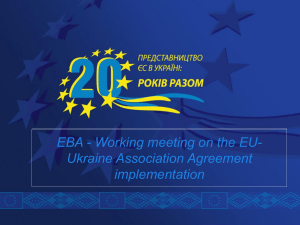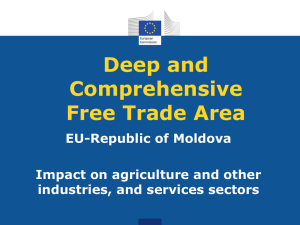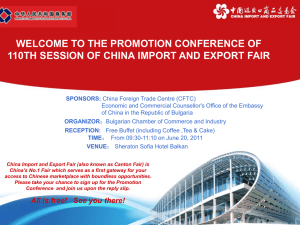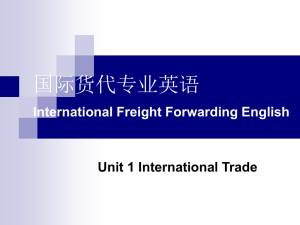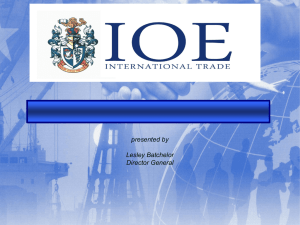Republic of Moldova
advertisement
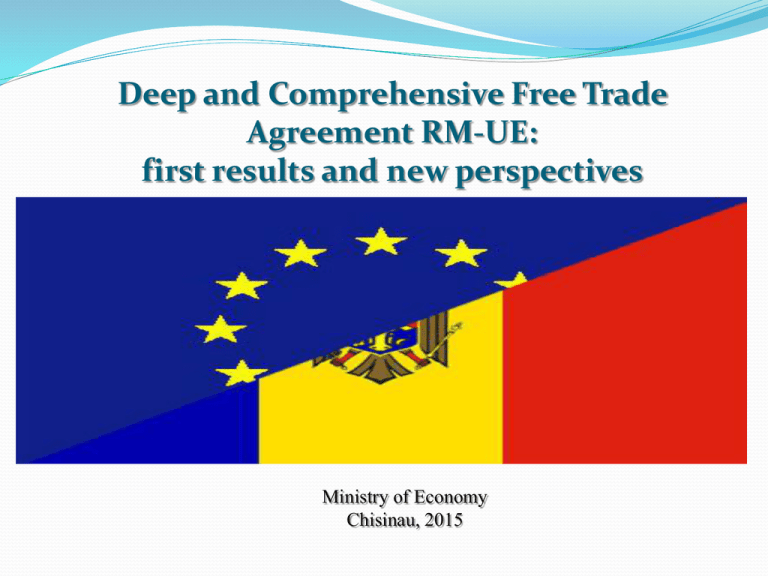
Deep and Comprehensive Free Trade Agreement RM-UE: first results and new perspectives Ministry of Economy Chisinau, 2015 Republic of Moldova: advantageous economic geo position Regional integration efforts of the Republic of Moldova Member OMC Member CEFTA Free Trade Agreement RM-Turkey Association Agreement RM-UE UE ATP+ GSP Member CSI DCFTA EU CEFTA CSI 505 mln. pers. 22 mln. pers. 279 mil. pers. Market Access 806 mil. pers. Evolution of international trade Mln. USD 5317 5492.69 5213.05 6000 5000 4000 3000 2399.03 2161.78 2339.5 2000 1000 0 2012 2013 2014 -1000 -2000 -3000 -3051.27 -3093.66 -4000 Export Import Balance of trade -2977.5 Import of goods Statistics by group of countries (% from whole import) Export of goods Statistics by group of countries (% from whole export ) UE CSI other countries UE 60 Other countries 50 53.3 50 CSI 45 47.3 46.9 48.3 45 44.5 40 42.9 40.5 35 40 31.2 30.5 30 31.4 30 24.5 24.3 25 27.3 24.4 20 20 15.3 15 12.2 10.2 10 10 5 0 0 2012 2013 2014 2012 2013 2014 Moldova's main trading partners in the EU 2014 Export 18,5% Romania 54.5% 10,6% 5,9% 4,6% 2.8% 1.6% 1,4% Italy Germany Great Britain Poland Bulgaria France Other countries Import 60,8% 15,6% 8,1% 6,9% 3,0% 2,2% 1,7% 1.6% Romania Germany Italy Poland Austria France Hungary Other countries The evolution of trade with the EU (september-november 2014) September October November 3000 Mii MDL 2500 2000 1500 1000 500 0 Apple Frozen sweet corn Table grapes Plums Corn Wines Beet sugar Wheat Barley September 37 60 150 175 234 1137 1386 1646 2221 October 143 173 293 178 1748 1571 487 1589 1164 November 155 0 786 17 1043 2967 1344 2591 223 The defining factors for assessing DCFTA’s potential impact on Moldovan’s exports The difficulty of economic entities to redirect immediately their exports to EU market, in the context of Russian embargo. The reduced capacities of economic entities to adapt their products/services to the requirements of the EU market. The ineligibility of RM to export goods of animal origin to EU market. Harnessing the full benefits of the DCFTA ‘s regime The extension of DCFTA’s applicability on goods of animal origin through implementation of DG SANCO’s recommendations, DCFTA’s provisions and finalization of institutional reform in the field of food safety in order to obtain status of exporting country to EU market. Improving the quality system in the country in order to increase the competitiveness of goods on foreign markets. The implementation and insurance of a functional system in the standardization, metrology and conformity assessment fields. Pan-Euro-Mediterranian cumulation Creation of diagonal cumulation zone between 42 countries; European Union(28 countries); Marocco, Algeria, Tunisia, Egypt, Israel, Lebanon, Syria, Jordan; Iceland, Lichtenstein, Norway and Switzerland (EFTA); CEFTA countries (Bosnia, Macedonia, Montenegro, Serbia, Albania, Kosovo); Turkey. The scope of Pan-Euro-Med Creating Free Trade Area in pan-euro-mediteranean space; Liberalization of rules of origin will: - Provide opportunities for the supply of raw materials; - Create new markets for raw materials; - Stimulate investments in the region. Harmonization of rules of origin. DCFTA benefits for exporters Unlimited access, without import tariff restrictions on the Community market of agricultural and industrial products; Elimination of customs tariffs; Secure perspectives for developing and stimulating of common business; Clear perspectives for export of animal products; Taking over the European standards and the norms of the quality infrastructure; Free and unconditional access to the Community market of services; Development of the national legislative framework in the field of competition; Expansion and coverage of protection over subjects of intellectual property; Consolidating the efforts in various fields in accessing on the foreign markets; Refocusing from trade to production; The possibility of granting technical and financial assistance from the EU. The tool for achieving the AA and DCFTA’s provisions In order to achieve the engagements undertaken by signing the Association Agreement, the Government of RM has approved: The National Action Plan for implementation of Association Agreement RM-EU 2014-2016 (Government Decision no. 808 /2014). The plan is very ambitious one and provides concrete actions for each Chapter of the Agreement. The main results in implementation of DCFTA Progress has been made in areas like: 1. Market access for goods: Law no. 172 /2014 for approval of Combined Nomenclature of goods; Government Decision no.971 /2014 (Regulation on the administration of tariff quotas on the import / export of goods); The implementation of “ASYCUDA WORLD” 2. Technical barriers to trade: Have been approved a series of Governments decisions on market surveillance, general safety of products, technical regulations fields. 3. Sanitary and phytosanitary issues: Have been transposed a series of important European Directives referring to measures necessary for protection of health and life of humans, animals or plants. The main results in implementation of DCFTA (2) 4. Customs and trade facilitation: Has been instituted a inter-ministerial Working Group which aim is to ensure the implementation of the DCFTA’s provisions referring to customs policies; Have been issued 54 AEO Certificates; Have been approved a series of decisions (Customs Service) on promoting electronic export declaration procedure; 5. Trade in services: The National Strategy for Information Society Development “Digital Moldova 2020” approved; Government Decision no. 701/2014 for approval of Methodology open government publishing the data methodology; The draft of “Post law” is in process of examination by Government; 6.Trade-related energy issues. Has been approved the Methodology of calculation and application of tariffs for natural gas; Have been elaborated different Regulations in the energy field. Government’s priorities for 2015 Ensure the uniform implementation of the new law on the Combined Nomenclature of goods; Approval of amendments to national legislation in order to transpose the obligations deriving from DCFTA (i.e. Article 195 (1)) by prohibiting parties, from January 1th of the year following the entry into force of the Agreement, to apply administrative charges having an effect equivalent to customs duties import or export licenses and other fees. To increase transparency in the administration of tariff quotas by posting a clear and accessible information for economic entities. Strict monitoring and fulfillment of the conditions of obtaining the right to export to the EU of animal products (poultry and eggs). Government’s priorities for 2015 (2) The completing of internal procedures for accession to the Convention on preferential rules of origin PanEuroMediterranian. (Ratification). Speed up the adoption and implementation of the Law on Public Procurement. The continuation of efforts to join the EA MLA Multilateral Recognition Arrangement. Identifying solutions on the application DCFTA in the Transnistrian region. Thank you for attention!!! Tel. 250 554 250 606
